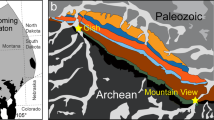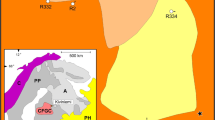Summary
Chemical compositions of orthopyroxene and clinopyroxene from the Jinchuan ultramafic intrusion have been obtained by electron microprobe analysis. The Mg′ number (MgO/(MgO + FeO)) for both pyroxenes falls within narrow ranges, 82–87 for clinopyroxene and 81–85.5 for orthopyroxene, suggesting limited magma differentiation in regard to the present igneous body. The Al2O3 content ranges from 2.44 wt.% to 4.43 wt.% and increases with decreasing Mg′ of the pyroxenes, i.e., with the more evolved magma. This is attributed to the relatively greater effects of Al2O3, TiO2, Cr2O3 and Fe2O3 than that of SiO2 on pyroxene crystallization.
Negative linear relationships between Ti4+ and Si4+, and Al3+ and Si4+ characterize the pyroxenes. In clinopyroxene, regression of Si4+ versus Al3+ results in a straight line with a slope of −1.012, indicating that the decrease of Si4+ in the crystal structure is matched by an increase only in tetrahedral Al3+; octahedral Al3+ has remained relatively constant. The negative linear relationship between Ti4+ and Si4+ in clinopyroxene reflects either a greater tendency of Ti4+ to occupy octahedral sites than Al3+, or that replacement of Al3+ for Si4+ demands a more efficient charge balance. The scatter in plots of Ti4+ versus Si4+ for orthopyroxene indicates that charge balance is not as critical as structure symmetry.
The crystallization temperature of pyroxene is calculated to be 1108–1229°C usingWood andBanno's (1973) two pyroxene thermometer, and is within 40°C of that calculated fromWells's (1977) thermometer. The distribution coefficient (Kd) for Mg2+ and Fe2+ between clinopyroxene and orthopyroxene is estimated to be 0.86, which is higher than that of the other intrusions and lower than that of mantle nodules, but still falls within their Kd-1/T trend. This suggests that the Kd value of pyroxene is controlled mainly by temperature.
Zusammenfassung
Die chemische Zusammensetzung von Orthopyroxenen und Klinopyroxenen aus der ultramafischen Jinchuan Intrusion wurden mit der Mikrosonde bestimmt. Die Mg-Zahl (MgO/(MgO + FeO)) beider Pyroxene liegt innerhalb enger Grenzen, 82–87 für Klinopyroxen und 81–85.5 für Orthopyroxen. Dies weist auf beschränkte magmatische Differentiation der Intrusion hin. Der Al2O3-Gehalt liegt zwischen 2.44 Gew.%. und 4.43 Gew.%. und nimmt mit der abnehmenden Mg-Zahl der Pyroxene ab, d.h. mit dem mehr entwickelten Magma. Dies wird damit erklärt, daß Al2O3, TiO2, Cr2O3 und Fe2O3 einen größeren Einfluß auf die Kristallisation der Pyroxene ausüben als SiO2.
Die Pyroxene werden durch negative lineare Beziehungen zwischen Ti4+ und Si4+, sowie Al3+ und Si4+ charakterisiert. In Klinopyroxenen resultiert die Regression von Si4+ gegen Al3+ in einer geraden Linie mit einer Neigung von −1.012. Dies weist darauf hin, daß die Abnahme der Si4+ Gehalte in die Kristallstruktur durch Zunahme von ausschliesslich tetraedrischem Al3+ kompensiert wird; oktaedrisches Al3+ ist relativ konstant geblieben. Die negative lineare Beziehung zwischen Ti4+ und Si4+ in Klinopyroxenen geht entweder auf eine stärkere Tendenz des Ti4O2, oktaedrische Plätze zu besetzen zurück, oder darauf daß ein Ersatz von Al3+ für Si4+ einen effizienteren Ladungsausgleich verlangt. Die unregelmäßige Verteilung der Plots von Ti4+ gegen Si4+ in Orthopyroxenen läßt erkennen, daß Ladungsausgleich hier nicht so kritisch ist wie die Symmetrie der Struktur.
Die Kristallisationstemperatur der Pyroxene wurde mit dem Zwei Pyroxenthermometer nachWood undBanno (1973) mit 1108–1229°C bestimmt. Diese Werte liegen innerhalb von 40°C des vonWells (1977) berechneten. Der Verteilungskoeffizient (Kd) für Mg2+ und Fe2+ zwischen Klinopyroxen und Orthopyroxen wird auf 0.86 berechnet; das ist höher als der aus anderen Intrusionen und niedriger als der von Mantelxenolithen, fällt aber immer noch innerhalb des Kd-1/T Trends derselben. Dies legt den Gedanken nahe, daß der Kd Wert der Pyroxene hauptsächlich durch Temperatur bestimmt wird.
Similar content being viewed by others
References
Atkins FB (1969) Pyroxenes of the Bushveld intrusion, South Africa. J Petrol 10: 222–249
Barnes SJ (1983) Petrology and geochemistry of a portion of the Howland (J-M) Reef of the Stillwater complex, Montana. Thesis, University of Toronto (unpublished)
Bartholomé P (1962) Co-existing pyroxenes in igneous and metamorphic rocks. Geol Mag 98: 346–348
Boyd FR (1973) A pyroxene geothermometer. Geochim Cosmochim Acta 37: 2533–2546
Boyd FR, Schairer JF (1964) The system MgSiO3-CaMgSi2O6. J Petrol 5: 257–309
Brown GM (1967) Experimental studies on inversion relations in natural pigeonitic pyroxenes. Yb Carnegie Inst Washington 66: 347–353
Campbell IH, Borley GD (1974) The geochemistry of pyroxenes from the lower layered series of the Jimberlana intrusion, Western Australia. Contrib Mineral Petrol 47: 281–297
Carmichael ISE (1967) The mineralogy of Thingmuli, a Tertiary volcano in eastern Iceland. Am Mineral 52: 1815–1841
Carmichael ISE, Nicholls J, Smithal (1970) Silica activity in igneous rocks. Am Mineral 55: 246–263
Carstens H (1958) Note on the distribution of some minor elements in coexisting ortho- and clino-pyroxenes. Norsk Geol Tidskr 38: 257–260
Chai G, Naldrett AJ (1992a) Characteristics of Ni-Cu-PGE mineralizatlon and genesis of the Jinchuan deposit, Northwest China. Econ Geol 87: 1475–1495
Chai G, Naldrett AJ (1992b) Petrology and geochemistry of the Jinchuan ultramafic intrusion: cumulate of a high Mg basaltic magma. J Petrol 33: 277–303
Davis BTC, Boyd FR Jr (1966) The join Mg2Si2O6-CaMgSi2O6 and its application to pyroxenes from kimberlites. J Geophys Res 71: 3567–3576
Davison PM, Grover J, Lindsley DH (1982) (Ca, Mg)2 Si2O6 clinopyroxenes: a solution model based on nonconvergent site-disorder. Contrib Mineral Petrol 80: 88–102
Deer WA, Howie RA, Zussman J (1978) {bcRock-forming minerals, vol 2A}. Single-chain silicates. Longman, London, 668p
Finger LW (1972) The uncertainty in the calculated ferric iron content of a microprobe analysis. Carnegie Inst Wash Yearb 71: 600–603
Gole MJ, Barnes SJ, Hill RET (1990) Partial melting and recrystallization of Archean komatiites by residual heat from rapidly accumulated flows. Contrib Mineral Petrol 105: 704–714
Green DH, Ringwood AE (1967) The genesis of basaltic magmas. Contrib Mineral Petrol 15: 103–190
Ghent ED, Coleman RG (1973) Eclogites from south-western Oregon. Geol Soc Am Bull 84: 2471–2488
Holland TJB, Navrotsky A, Newton RC (1979) Thermodynamic parameters of CaMgSi2O6-Mg2Si2O6 pyroxenes based on regular solution and cooperative disordering models. Contrib Mineral Petrol 69: 337–344
Kretz R (1961) Some applications of thermodynamics to coexisting minerals of variable composition. J Geol 69: 361–387
Kretz R (1963) Distribution of magnesium and iron between orthopyroxene and calcic pyroxene in the natural mineral assemblages. J Geol 71: 773–785
Kretz R (1982) Transfer and exchange equilibrium in a portion of the pyroxene quadrilateral as deduced from natural and experimental data. Geochim Cosmochim Acta 46: 411–421
Kushiro I (1960) Si-Al relations in clinopyroxenes from igneous rocks. Am Sci 258: 548–554
Lebas NJ (1962) The role of aluminium in igneous clinopyroxenes with relation to their parentage. Am J Sci 260: 267–288
Lindsley DH (1983) Pyroxene thermometry. Am Mineral 68: 477–493
Lindsley DH, Andersen DJ (1983) A two-pyroxene thermometer. Proc 13th Lunar and Planet Sci Conf JGR [Suppl] 88: 887–906
Lindsley DH, Grover JE, Davidson PM (1981) The thermodynamics of the Mg2Si2O6-CaMgSi2O6 join: a review and an improved model. In:Newton RC, Navrosky A, Wood BJ (eds) Advances in physical geochemistry 1. Springer, New York, pp 149–175
Mueller RF (1960) Compositional characteristics and equilibrium relations in mineral assemblages of a metamorphosed iron formation. Am J Sci 258: 449–497
Mueller RF (1961) Analysis of relations among Mg, Fe and Mn in certain metamorphic minerals. Geochim Cosmochim Acta 25: 267–296
Naldrett AJ, Kullerud G (1967) A study of the Strathcona mine and its bearing on the origin of the nickel-copper ores of the Sudbury District, Ontario. J Petrol 8: 453–531
Nixon PH, Boyd FR (1974) The discrete nodule association in Kimberlites from the northern Lesotho. In:Nixon PH (ed) Lesotho kimberlites. Lesotho National Development Corporation, Maseru, Lesotho, pp 67–75
Robinson P (1980) The composition space of terrestrial pyroxenes-internal and external limits. In:Pyroxene CT (ed) Pyroxenes. Rev Mineral 7: 419–494
Ryburn RJ, Raheim A, Green DH (1976) Determination of the P. T. paths of natural eclogites during metamorphism-record of subduction. A correction to a paper by Raheim and Green (1975). Lithos 9: 161–164
Saxena SK (1968) Distribution of iron and magnesium between coexisting garnet and clinopyroxene in rocks of varying metamorphic grade. Am Mineral 53: 2018–2024
Saxena SK (1976) Two pyroxene geothermometer: a model with an approximate solution. Am Mineral 61: 643–652
S.G.U. (1984) Geology of Baijiazuezhi Cu-Ni deposit (in Chinese). Geological publication bureau, China, 325p
Wager LR, Brown GM (1968) Layered igneous rocks. Oliver and Boyd, Edinburgh London, 588p
Wells PRA (1977) Pyroxene thermometry in simple and complex systems. Contrib Mineral Petrol 62: 129–139
Wilson AH (1982) The geology of the Great Dyke, Zimbabwe: the ultramafic rocks. J Petrol 23: 240–292
Wood BJ, Banno S (1973) Garnet-orthopyroxene and orthopyroxene and clinopyroxene relationships in simple and complex systems. Contrib Mineral Petrol 42: 109–124
Author information
Authors and Affiliations
Additional information
With 6 Figures
Rights and permissions
About this article
Cite this article
Chai, G., Naldrett, A.J. Pyroxene mineral chemistry of the Jinchuan intrusion, China. Mineralogy and Petrology 51, 1–20 (1994). https://doi.org/10.1007/BF01164911
Received:
Accepted:
Issue Date:
DOI: https://doi.org/10.1007/BF01164911




